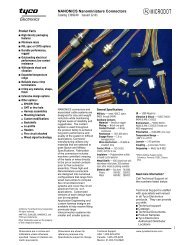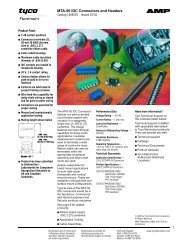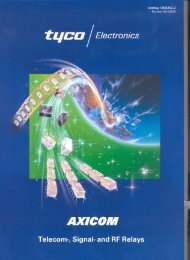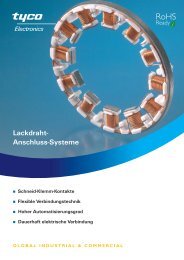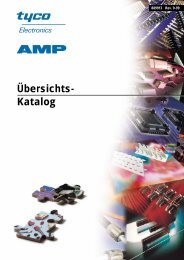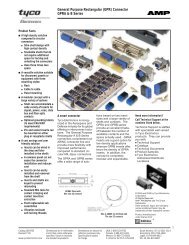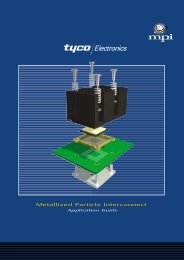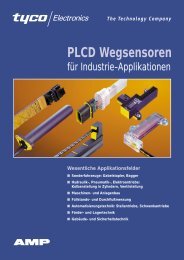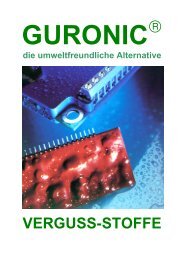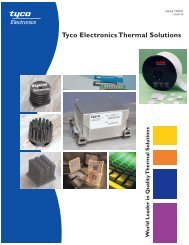M Series Pin and Socket Connectors
M Series Pin and Socket Connectors
M Series Pin and Socket Connectors
You also want an ePaper? Increase the reach of your titles
YUMPU automatically turns print PDFs into web optimized ePapers that Google loves.
The total current capacity of<br />
each contact in a given connector<br />
is dependent upon the<br />
heat rise resulting from the<br />
combination of electrical loads<br />
of the contacts in the connector<br />
arrangement <strong>and</strong> the maximum<br />
ambient temperature in which<br />
the connector will be operating.<br />
Caution must be taken to<br />
ensure that this combination of<br />
conditions does not cause the<br />
internal temperature of the connector<br />
to exceed the maximum<br />
operating temperature of the<br />
housing material. Several variables<br />
which must be considered<br />
when determining this maximum<br />
current capability for your<br />
application are:<br />
■ Wire Size—Larger wire will<br />
carry more current since it<br />
has less internal resistance<br />
to current flow <strong>and</strong> generates<br />
less heat. The wire also conducts<br />
heat away from the<br />
connector.<br />
Current Rating Verification<br />
Can a contact rated at 10 amps<br />
carry 10 amps?<br />
Maybe yes, but probably not.<br />
The reason lies in the test conditions<br />
used to rate the contact.<br />
If these conditions do not adequately<br />
reflect the application<br />
conditions, the actual allowable<br />
current levels may be lower<br />
than specified levels. For example,<br />
many manufacturers,<br />
including Tyco, test a single<br />
contact in air. This gives an<br />
accurate measure of the basic<br />
current-carrying capacity of the<br />
contact. Use the contact alone<br />
in air <strong>and</strong> it can certainly carry<br />
10 amperes. Use it in a multiposition<br />
connector surrounded<br />
by other current-carrying contacts<br />
or in high ambient<br />
temperatures, <strong>and</strong> the contact<br />
should carry less current.<br />
Similarly, as the contact ages<br />
<strong>and</strong> stress relaxation, environmental<br />
cycling, <strong>and</strong> other<br />
degradation factors take their<br />
toll, the contact’s currentcarrying<br />
capacity decreases.<br />
A prudent design must set<br />
current levels for such end-ofdesign-life<br />
(EODL) conditions.<br />
Dimensions are shown for reference<br />
purposes only.<br />
M <strong>Series</strong><br />
<strong>Pin</strong> <strong>and</strong> <strong>Socket</strong> <strong>Connectors</strong><br />
Current Carrying Capabilities<br />
75<br />
60<br />
45<br />
30<br />
15<br />
0<br />
CONTACT CURRENT GUIDE Maximum Current (Amperes)<br />
60<br />
56<br />
50<br />
■ Connector Size—In general,<br />
with more circuits in a connector,<br />
less current per<br />
contact can be carried.<br />
Practical current-carrying capacity<br />
is not an absolute, but an<br />
application-dependent condition.<br />
New Method Simplifies Ratings<br />
To help the designer set the<br />
appropriate current level, Tyco<br />
has developed a method of<br />
specifying current-carrying<br />
capacity. This method takes<br />
into account the various application<br />
factors that influence<br />
current rating.<br />
The method can be summarized<br />
as follows:<br />
■ The contact is aged to EODL<br />
conditions by durability<br />
cycling, thermal cycling, <strong>and</strong><br />
environmental exposure.<br />
■ The contact’s resistance<br />
stability is verified.<br />
45<br />
■ The current necessary to<br />
p r oduce the specified temperature<br />
rise is measured. This<br />
T-rise is usually 30°C.<br />
■ A rating factor is determined<br />
to allow derating of multiple<br />
contacts in the same housing<br />
<strong>and</strong> for different conductor<br />
sizes.<br />
Dimensions are in inches <strong>and</strong> millimeters<br />
unless otherwise specified.<br />
Values in brackets are metric equivalents.<br />
35<br />
23<br />
■ Current Load Distribution—<br />
Spreading those lines with<br />
greater current loads throughout<br />
the connector, particularly<br />
around the outer perimeter,<br />
will enhance heat dissipation.<br />
Temperature<br />
13<br />
11.85<br />
7.5<br />
One other factor influencing<br />
current levels is the maximum<br />
operating temperature, for<br />
example, 105°C. If the application<br />
has a high ambient<br />
temperature (over 75°C) the<br />
contact’s T-rise is limited by<br />
the maximum operating temperature.<br />
For example, an<br />
application temperature of<br />
90°C limits the contact T-rise<br />
to 15°C. Since current produces<br />
heat (the I 2R law), the<br />
current must be lowered to<br />
limit the T-rise.<br />
A contact’s T-rise depends not<br />
only on its I 2R Joule heating, but<br />
also on its ability to dissipate<br />
the heat. Consider a contact in<br />
a multi-contact housing. Joule<br />
heating in multiple contacts will<br />
raise the local ambient temperature.<br />
Since the contact will not<br />
be able to dissipate its own<br />
heat as well by convection, the<br />
maximum T-rise will be realized<br />
at a lower current level. Consequently,<br />
the allowable current<br />
level must be lower to maintain<br />
an acceptable T-rise.<br />
For a given connector, the<br />
current level will be set by the<br />
loading density. A connector<br />
Specifications subject to change. Technical Support Center<br />
1-800-522-6752<br />
www.tycoelectronics.com<br />
Catalog 82003<br />
Revised 3-01<br />
Type XII Upgrade<br />
Size 8 Upgrade<br />
.125 POWERBAND<br />
Contact<br />
Size 8<br />
Type XII<br />
Type I, Type II/III+<br />
Upgrade<br />
Type III+, Type II,<br />
Type III+ Posted<br />
Size 20 Upgrade<br />
20 DF<br />
■ Ambient Temperature—With<br />
higher ambient temperatures,<br />
less current can be carried.<br />
containing 50% current-carrying<br />
contacts will permit higher<br />
currents (per contact) than a<br />
connector will at 75% loading.<br />
The loading percentage assumes<br />
an even distribution of contacts<br />
within the housing. If all 10 contacts<br />
are grouped together in<br />
one section of a 20-position<br />
connector, the loading density<br />
may approach 100%.<br />
The Importance of EODL<br />
As stated, T-rise in a contact<br />
depends on both resistance <strong>and</strong><br />
current. As it ages, a contact’s<br />
resistance will increase. The<br />
contact designer will specify a<br />
maximum resistance for the<br />
contact, this level is the end-ofdesign-life<br />
resistance. Before<br />
the contact is tested for current,<br />
Tyco subjects it to a sequence<br />
of tests that exercises the major<br />
failure mechanisms <strong>and</strong> thereby<br />
simulates EODL conditions.<br />
Conditioning includes mating<br />
cycling, industrial mixed-flowing<br />
gases, humidity <strong>and</strong> temperature<br />
cycling, <strong>and</strong> vibration to<br />
sequentially introduce wear,<br />
corrosion, stress relaxation,<br />
<strong>and</strong> mechanical disturbance.<br />
7



